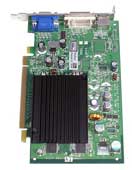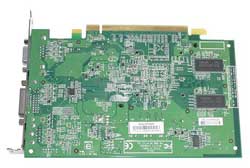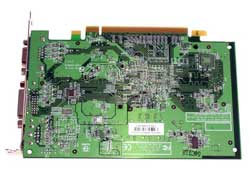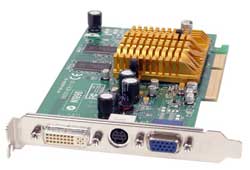Buyer's Guide - Entry Level to Mid-Range, March 2005
by Jarred Walton on March 15, 2005 1:30 PM EST- Posted in
- Guides
Video Cards
Assuming that you haven't selected one of the alternative motherboards with integrated graphics - or that you're looking for improved graphics performance - we have two different options. The socket 754 platform is currently AGP-only, although perhaps we'll see some PCIe boards using the nForce4 or a similar chipset in the future. The 939 and Intel platforms, on the other hand, are PCIe-only. (You could get a 939 AGP motherboard as well, of course.) The graphics recommendations will be different for each platform out of necessity, although we will try to keep price/performance as close as possible.AGP Graphics Recommendation:MSI Radeon 9550 128MB DDR 128-bit, 250/400 GPU/RAM clock (bulk/OEM)
Price: $67 shipped
For basic 3D graphics, the Radeon 9550 offers DirectX 9 support with enough performance to run most games that are two or three years old, and perhaps even more recent titles - at reduced quality levels. This is certainly no gamer card, but it does meet the minimum DX9 hardware requirement for the next version of Windows (Longhorn with eye candy enabled), and it will allow you to run either DVI or VGA displays along with providing TV-out support. There isn't a whole lot to differentiate the 9550 cards from one another, as they all run at similar clock speeds. We prefer the fanless varieties, of course, as they won't add any noise pollution to the room. If you can find some other brand for less money, it should be okay.
If you want more from your graphics, consider the GeForce 6200 AGP, 6600 AGP, and 6600GT AGP as the next three upgrades in order of performance. Their prices are around $100, $150, and $200 respectively, so you pay a lot more for the added performance. The Radeon 9600 (without the SE) is also a decent alternative that will only cost an extra $15. It's basically the same as the 9550 but with a faster core clockspeed (325MHz vs. 250MHz). For the price, we'd definitely stay away from the SE 9550 and 9600 cards.
 |
 |
| Click images to enlarge. | |
PCIe Graphics Recommendation: Leadtek GeForce 6200TC 64-bit, 64MB (256 shared) PCIe with 350 MHz core
Price: $71 shipped
If you missed our article on the new 6200 TurboCache cards from NVIDIA, now would be a good time to check it out. These are once again budget parts, but they manage to reduce price in an interesting way. With the added bandwidth of the PCI Express bus, the amount of graphics RAM on the cards can be reduced and system RAM can be used instead, all without seriously degrading performance. 16MB and 32MB versions can utilize up to 128MB of system RAM, and 64MB versions can use up to 256MB of system RAM. As with the 9550, the total performance level is still relatively low, but the 6200TC-32 is generally slightly faster than the 9600SE and X300SE while the 6200TC-64 is faster than the 9600/X300.
 |
 |
| Click images to enlarge. (Sample images of 16MB 16-bit 6200TC.) |
|
The TurboCache cards are available with either 32-bit or 64-bit memory interfaces, with core clock speeds ranging between 300 MHz and 350 MHz. The best price/performance is the 32MB 64-bit version, which is only slightly more expensive than the 16MB version. Look closely at what is being sold, however, as not all manufacturers or resellers are entirely clear on the specifications of the product being sold. If you can find some good pictures of the card, the presence of four RAM chips - two on each side - indicates that the card is a 64MB, 64-bit version. Two chips means that it's the 32MB, 32-bit model, and a single chip indicates that it's the low-end 16MB, 32-bit model. The full 128MB cards with 128-bit interfaces will have eight chips. To help you understand the differences, we have included two shots of the 6200TC-64 Leadtek card (front and back views) above. Compare that with the following images of a 6200TC-16 Leadtek card, and you can see the missing RAM chips.
PCIe Graphics Alternative:Leadtek GeForce 6600 128-bit, 128MB PCIe 300/550 MHz GPU/RAM
Price: $109 shipped
The full 6200 with 128-bit memory interface is the best of the "value" graphics chips, but with a price hovering just over $ 100, it's a pretty big jump. The better value at that range - at least for PCI Express - is to go with the 6600 chipset. It's supposed to be a "mid-range" part, and MSRP was initially $150, but the price has dropped quite a bit now. As most graphics chips are bandwidth limited with these cards, the jump from a 64-bit interface to a 128-bit interface improves performance quite a lot, particularly as resolutions increase. (If you're going with an AGP configuration, 6600 cards cost quite a bit more, so the 6200 128-bit is the better pick.) Overall performance of the 128-bit cards is generally better than the 9600 Pro cards of previous Guides, although not by a huge margin.
It is interesting to note that the current street prices on all the 6200 cards are quite a bit lower than the original estimates that we received from NVIDIA. The upgrade from the 16MB to 32MB cards is virtually free, with even the 64MB cards costing less than the original 6200 128MB cards. That's a good thing in our book, especially considering that the original 128-bit 6200 card is still the fastest of the bunch. For further performance increases, you'll need to look to the 6600 and 6600GT cards, just like on the AGP platform. If the X800 cards from ATI start to hit the $199 MSRP, that would also be a great option, albeit firmly in the mid-range price segment.
Update: Thanks to the reader comments for reminding us that the 9550 128-bit is a better choice than the 9600SE. The decreased GPU speed is typically less important than the increased memory bandwidth at this price point. They also pointed out the price drop on the 6600 PCIe cards, making them a better selection than the 6200 as an alternative. However, we still like the Gigabyte 6200 card initially listed as the alternative recommendation due to the inclusion of component output. If gaming isn't a concern but component output is, you might want to go with that instead of the 6600.












59 Comments
View All Comments
jwf1776 - Tuesday, March 22, 2005 - link
my sources are showing Thermaltake W0013 Xaser Silent Purepower 480W at $60 as the cheapest acceptable atx 2.03 availablejwf1776 - Tuesday, March 22, 2005 - link
47 - the point is that it was "important to make sure that the alternative PSU included a 24-pin power connector" and it did notyou dig?
Jep4444 - Tuesday, March 22, 2005 - link
a 20-pin PSU will work on a 24-pin mobojwf1776 - Tuesday, March 22, 2005 - link
the alternative power supply EG375P-VE-SFMA doesn't have a 24pin rail!!http://www.enermax.com.tw/products_page.php?Tid=1&...
I ordered it at found out the hard way.
please make a correction!
Jep4444 - Thursday, March 17, 2005 - link
http://www.hkepc.com/hwdb/x300hm-5.htmlooking at those X300HM, you can clearly see the higher memory HyperMemory cards fair better with AA than the higher clocked low memory ones
scrolling down the page, their isn't a direct 32MB/64MB comparison of the 6200TC but both are benched and you can see the 64MB 6200TC is faster than the 32MB only when AA is on
I guess it doesn't entirely matter though given the 32MB one can't even be found on newegg ATM(or atleast i couldn't find one)
JarredWalton - Wednesday, March 16, 2005 - link
41 - Ah, that could very well be. In that case, I'd be curious to see the difference in performance between the 32MB and 64MB 64-bit TC cards. :|JarredWalton - Wednesday, March 16, 2005 - link
42 - I had no idea Rosewill was related to Newegg. Newegg itself is just the online reseller of another company, ABS Computers or some such. At least, that was my understanding. Rosewill's RMA process seems a little questionable (i.e. restrictive), which doesn't really jive with them being Newegg. Of course, maybe it's just Newegg's way to sell certain products without needing to provide as much customer support?Zepper - Wednesday, March 16, 2005 - link
Just in case the author didn't know, Rosewill isn't an independent company. It is the in-house packaging division of Newegg (like Mad Dog is to CompUSA, etc.). You can often find the same item for less under its actual name than in a Rosewill box..bh.
Jep4444 - Wednesday, March 16, 2005 - link
The one benchmarked in the article under the name 64b is the 32MB/64bit one as mentioned on the first page and the 32b is 16MB/32bitI've seen a couple benches suggesting that the onboard RAM only makes a noticeable difference when AA is turned on at which point the 32MB cards seem to hit rock bottom dropping a significant amount of FPS(the ATI one does it too)
JarredWalton - Wednesday, March 16, 2005 - link
Jep4444 - I'm still not entirely sure on whether the 6200TC-32 is a 32-bit or 64-bit interface. Looking at the performance, it appears to be a 32-bit interface as the TC-64 beats it by a large margin. Then again, the presence of more local memory might cause the performance difference. Anyway, regardless of whether the TC-32 is a 32-bit or 64-bit interface, I would definitely stick with the TC-64 or full 6200 over the TC-16/32.